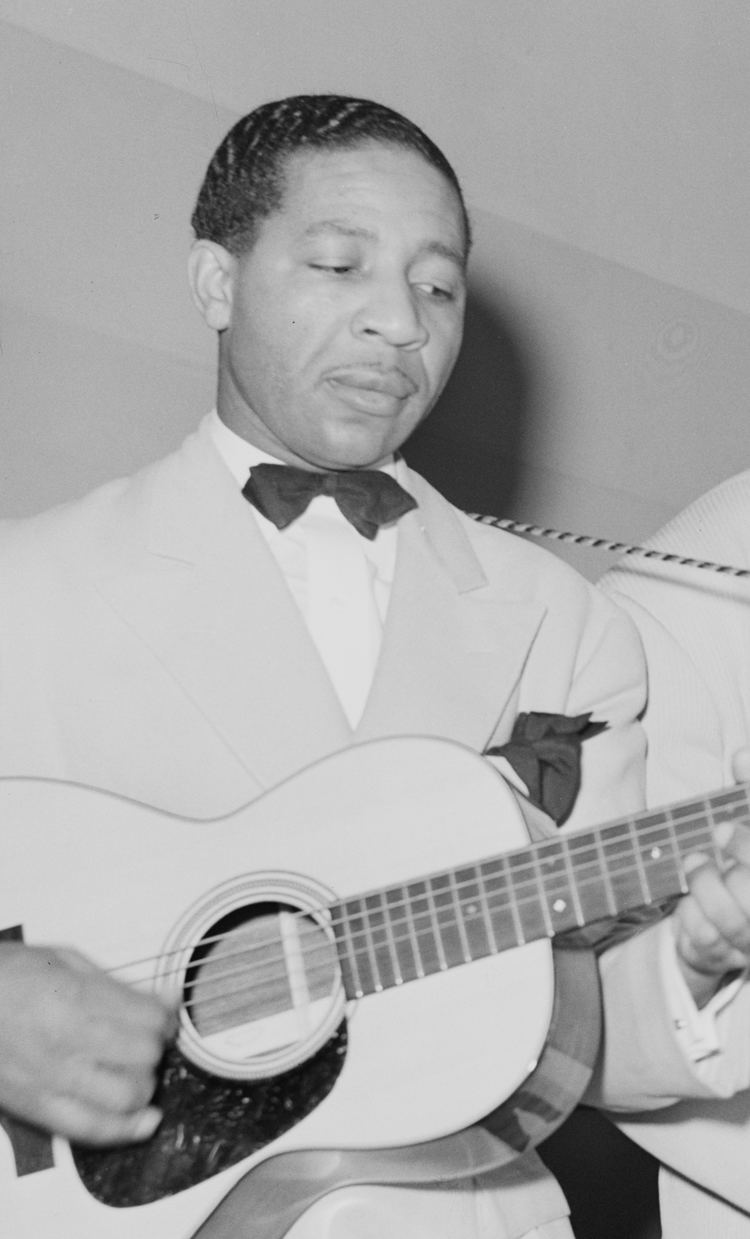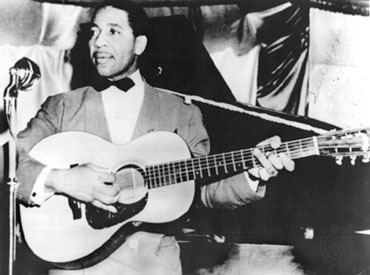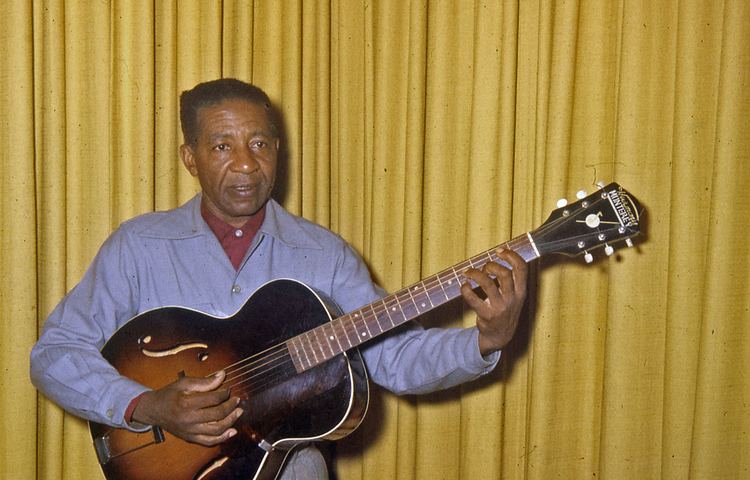Birth name Alonzo Johnson Role Singer Name Lonnie Johnson | Origin New Orleans, Louisiana | |
Born February 8, 1899 ( 1899-02-08 ) Died June 16, 1970, Ontario, Canada Movies The American Folk-Blues Festival: The British Tours 1963-1966 Albums Blues & Ballads, The Complete Folkways, Roots 'n Blues: The Retrospe, A Life In Music Selected, Blues by Lonnie Johnson | ||
Instruments Guitar, Vocals, violin | ||
Lonnie johnson swingin the blues 1966
Alonzo "Lonnie" Johnson (February 8, 1899 – June 16, 1970) was an American blues and jazz singer, guitarist, violinist and songwriter. He was a pioneer of jazz guitar and jazz violin and is recognized as the first to play an electrically amplified violin.
Contents
- Lonnie johnson swingin the blues 1966
- Lonnie johnson too late to cry
- Early career
- Success in the 1920s and 1930s
- Later career
- Biopic depiction
- Influence
- References

Lonnie johnson too late to cry
Early career

Johnson was born in New Orleans, Louisiana, and raised in a family of musicians. He studied violin, piano and guitar as a child and learned to play various other instruments, including the mandolin, but he concentrated on the guitar throughout his professional career. "There was music all around us," he recalled, "and in my family you'd better play something, even if you just banged on a tin can."

Johnson pioneered the single-string solo guitar styles that have become customary in modern rock, blues and jazz music.

By his late teens, he was playing guitar and violin in his father's family band at banquets and weddings, alongside his brother James "Steady Roll" Johnson. He also worked with the jazz trumpeter Punch Miller in the Storyville district of New Orleans.
In 1917, Johnson joined a revue that toured England, returning home in 1919 to find that all of his family, except his brother James, had died in the 1918 influenza epidemic.
He and his brother settled in St. Louis in 1921, where they performed as a duo. Lonnie also worked on riverboats and in the orchestras of Charlie Creath and Fate Marable.
In 1925 Johnson married, and his wife, Mary, soon began a blues career of her own, performing as Mary Johnson and pursuing a recording career from 1929 to 1936. (She is not to be confused with the later soul and gospel singer of the same name.) As with many other early blues artists, information on Mary Johnson is often contradictory and confusing. Various online sources give her name before marriage as Mary Smith and state that she began performing in her teens. However, the writer James Sallis gave her original name as Mary Williams and stated that her interest in writing and performing blues began when she started helping Lonnie write songs and developed from there. The two never recorded together. They had six children before their divorce in 1932.
Success in the 1920s and 1930s
In 1925, Johnson entered and won a blues contest at the Booker T. Washington Theatre in St. Louis, the prize being a recording contract with Okeh Records. To his regret, he was then tagged as a blues artist and later found it difficult to be regarded as anything else. He later said, "I guess I would have done anything to get recorded – it just happened to be a blues contest, so I sang the blues." Between 1925 and 1932 he made about 130 recordings for Okeh, many of which sold well (making him one of the most popular OKeh artists). He was called to New York to record with the leading blues singers of the day, including Victoria Spivey and the country blues singer Alger "Texas" Alexander. He also toured with Bessie Smith, a top attraction of the Theater Owners Bookers Association.
In December 1927, Johnson recorded in Chicago as a guest artist with Louis Armstrong and His Hot Five, paired with the banjoist Johnny St. Cyr. He played on the sides "I'm Not Rough", "Savoy Blues", and "Hotter Than That." In an unusual move, he was invited to sit in with many OKeh jazz groups. In 1928 he recorded "Hot and Bothered", "Move Over", and "The Mooche" with Duke Ellington for Okeh. He also recorded with a group called the Chocolate Dandies (in this case, McKinney's Cotton Pickers). He pioneered the guitar solo on the 1927 track "6/88 Glide", and on many of his early recordings he played 12-string guitar solos in a style that influenced such future jazz guitarists as Charlie Christian and Django Reinhardt and gave the instrument new meaning as a jazz voice. He excelled in purely instrumental pieces, some of which he recorded with the white jazz guitarist Eddie Lang, with whom he teamed in 1929. These recordings were among the first to feature black and white musicians performing together, although Lang was credited as Blind Willie Dunn to disguise the fact.
Much of Johnson's music featured experimental improvisations that would now be categorised as jazz rather than blues. According to the blues historian Gérard Herzhaft, Johnson was "undeniably the creator of the guitar solo played note by note with a pick, which has become the standard in jazz, blues, country, and rock". Johnson's style reached both the Delta bluesmen and urban players who would adapt and develop his one-string solos into the modern electric blues style. However, the writer Elijah Wald declared that in the 1920s and 1930s Johnson was best known as a sophisticated and urbane singer rather than an instrumentalist: "Of the forty ads for his records that appeared in the Chicago Defender between 1926 and 1931, not one even mentioned that he played guitar."
Johnson's compositions often depicted the social conditions confronting urban African Americans ("Racketeers' Blues", "Hard Times Ain't Gone Nowhere", "Fine Booze and Heavy Dues"). In his lyrics he captured the nuances of male-female love relationships in a way that went beyond Tin Pan Alley sentimentalism. His songs displayed an ability to understand the heartaches of others, which Johnson saw as the essence of his blues.
After touring with Bessie Smith in 1929, Johnson moved to Chicago and recorded for Okeh with the stride pianist James P. Johnson. However, with the temporary demise of the recording industry in the Great Depression, he was compelled to make a living outside music, working at one point in a steel mill in Peoria, Illinois. In 1932 he moved again, to Cleveland, Ohio, where he lived for the rest of the decade. There he performed on radio programs and intermittently played with the band backing the singer Putney Dandridge.
By the late 1930s, he was recording and performing in Chicago for Decca Records, working with Roosevelt Sykes and Blind John Davis, among others. In 1939, during a session for Bluebird Records with the pianist Joshua Altheimer, Johnson used an electric guitar for the first time. He recorded 34 tracks for Bluebird over the next five years, including the hits "He's a Jelly Roll Baker" and "In Love Again".
Later career
After World War II, Johnson made the transition to rhythm and blues, recording for King Records in Cincinnati, and having a major hit in 1948 with "Tomorrow Night", written by Sam Coslow and Will Grosz. It topped the Billboard Race Records chart for 7 weeks and reached number 19 on the pop chart, with reported sales of three million copies. A blues ballad with piano accompaniment and background singers, the song bore little resemblance to much of Johnson's earlier blues and jazz material. The follow-ups "Pleasing You", "So Tired" and "Confused" were also R&B hits.
In 1952 Johnson toured England. Tony Donegan, a British musician who played on the same bill, paid tribute to Johnson by changing his name to Lonnie Donegan. Johnson's performances are thought to have been received poorly by British audiences; this may have been due to organisational problems with the tour.
After returning to the United States, Johnson moved to Philadelphia. His career had been a roller coaster ride that sometimes took him away from music. Between great musical accomplishments, he had found it necessary to take menial jobs, ranging from working in a steel foundry to mopping floors as a janitor. He gradually dropped out of the music industry again in the 1950s and took menial jobs. He was working at the Benjamin Franklin Hotel in Philadelphia in 1959 when WHAT-FM disc jockey Chris Albertson located him and produced a comeback album for the Prestige Bluesville Records label, Blues by Lonnie Johnson. This was followed by other Prestige albums, including one (Blues & Ballads) with the former Ellington boss Elmer Snowden, who had helped Albertson locate Johnson. (Snowden had been the original bandleader of a jazz group called the Washingtonians, which Ellington took over after Snowden vacated the position and made into the famous Ellington orchestra.) There followed a Chicago engagement for Johnson at the Playboy Club. This succession of events placed him back on the music scene at a fortuitous time: young audiences were embracing folk music, and many veteran performers were stepping out of obscurity. In short order, Johnson was reunited with Duke Ellington and his orchestra and appeared as a special guest at an all-star folk concert, both performances of which were staged at Town Hall, in New York City.
In 1961, Johnson was reunited with his old Okeh recording partner Victoria Spivey for another Prestige album, Idle Hours, and the two singers performed at Gerdes Folk City. In 1963 he toured Europe as part of the American Folk Blues Festival, with Muddy Waters and others, and recorded an album with Otis Spann in Denmark.
In May 1965, he performed at a club in Toronto before an audience of four people. Two weeks later, his shows at a different club attracted a larger audience, and Johnson, encouraged by Toronto's relative racial harmony, decided to move to the city. He opened his own club, Home of the Blues, on Toronto's Yorkville Avenue in 1966, but it was a business failure, and Johnson was ultimately fired by the man who became owner. Through the rest of the decade he recorded, played clubs in Canada and embarkied on several regional tours.
In March 1969, he was hit by a car while walking on a sidewalk in Toronto. He was seriously injured, suffering a broken hip and kidney injuries. A benefit concert was held on May 4, 1969, featuring two dozen acts, including Ian and Sylvia, John Lee Hooker and Hagood Hardy. Johnson never fully recovered from his injuries and suffered what was described as a stroke in August. He was able to return to the stage for one performance at Massey Hall on February 23, 1970, walking with the aid of a cane, to sing a couple of songs with Buddy Guy; Johnson received a standing ovation.
Johnson died on June 16, 1970. A funeral was held at Mount Hope Cemetery in Toronto by his friends and fellow musicians, but his family members insisted on transferring the body to Philadelphia, where he was buried. At the time, Johnson was reported to have been "virtually broke." The Killer Blues Headstone project, a nonprofit organization that places headstones on unmarked graves of blues artists purchased a headstone for Johnson around 2014.
In 1993, Smithsonian Folkways released The Complete Folkways Recordings, an anthology of Johnson's music, on Folkways Records. He had been featured on several compilation blues albums from Folkways, beginning in the 1960s, but never released a solo album on the label in his lifetime.
Johnson was posthumously inducted into the Louisiana Blues Hall of Fame in 1997.
Biopic depiction
Johnson is a character in Who Do You Love? (2008), a feature film that dramatised the life of Leonard Chess, starring Alessandro Nivola, David Oyelowo and TJ Hassan as Johnson. The film was directed by Jerry Zaks.
Influence
Johnson's early recordings are the first guitar recordings that display a single-note soloing style with string bending and vibrato. Johnson pioneered this style of guitar playing on records, and his influence is obvious in the playing of Django Reinhardt, T-Bone Walker and virtually all electric blues guitarists.
One of Elvis Presley's earliest recordings was a version of Johnson's blues ballad "Tomorrow Night", written by Sam Coslow and Will Grosz. Presley's vocal phrasing mimics Johnson's, and many of Presley's signature vibrato and baritone sounds can be heard in development. "Tomorrow Night" was also recorded by LaVern Baker and (in 1957) by Jerry Lee Lewis.
In the liner notes for the album Biograph, Bob Dylan described his encounters with Johnson in New York City. "I was lucky to meet Lonnie Johnson at the same club I was working and I must say he greatly influenced me. You can hear it in that first record. I mean Corrina, Corrina...that's pretty much Lonnie Johnson. I used to watch him every chance I got and sometimes he'd let me play with him. I think he and Tampa Red and of course Scrapper Blackwell, that's my favorite style of guitar playing." In his autobiography, Chronicles, Vol. 1, Dylan wrote about the performing method he learned from Robert Johnson and remarked that Robert Johnson had learned a lot from Lonnie Johnson. Some of Robert Johnson's songs are seen as new versions of songs recorded by Lonnie Johnson.
